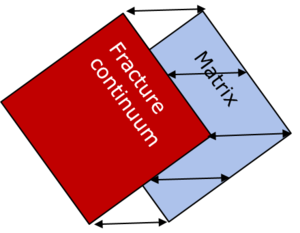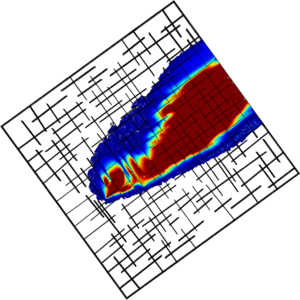Model concepts
Contents
Model concepts
For the modeling of flow and transport in fractured porous media, different kinds of model concepts have been developed. Here is an overview of the major groups.
Equivalent porous-medium model (EPM)
The equivalent porous medium model is a basic model concept and simulates a porous medium with parameters averaged over control volumes containing both fractures and limestone matrix. The model consists of a flow model and a transport model. The fractures are not explicitly modeled, instead being accounted for in a bulk or average hydraulic conductivity. Due to its simplicity and its low computational effort, the EPM model is widely used. It consists of a flow equation and a transport equation. Darcy's law is usually employed for the calculation of the flow velocities.
Dual-continuum model
A dual-continuum model uses two or more coupled continua. One refers usually to the matrix and the other one to the fracture continuum. Different parameters and equations are used in the continua. They are coupled via exchange fluxes in the source and sink terms. The quantification of these exchange fluxes is usually non-trivial.
Discrete-fracture model (DFM)
The discrete-fracture model (DFM) is the most detailed approach for fracture flow and transport modeling. It discretizes the (major) fractures embedded in the porous matrix explicitly. Usually, the fractures are resolved with one dimension less than the matrix (e.g. matrix in 3D, fractures in 2D). The fractures have to be characterized by properties like aperture, lenght, spacing, main orientation. Fractures and matrix are usually coupled at the fracture-matrix interface by flux continuity and continuity of the primary variables (hydraulic head, concentration).
Return to Content

